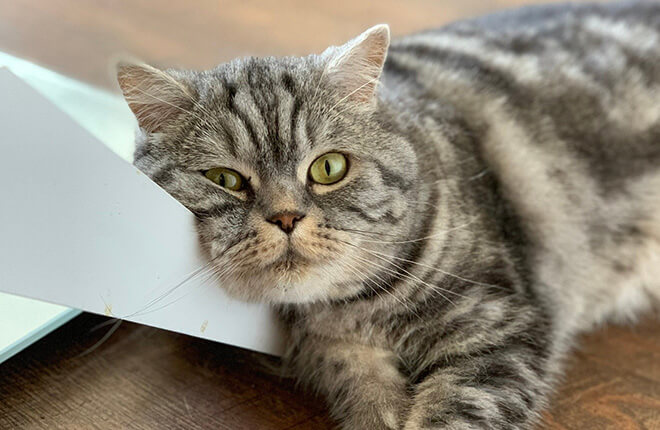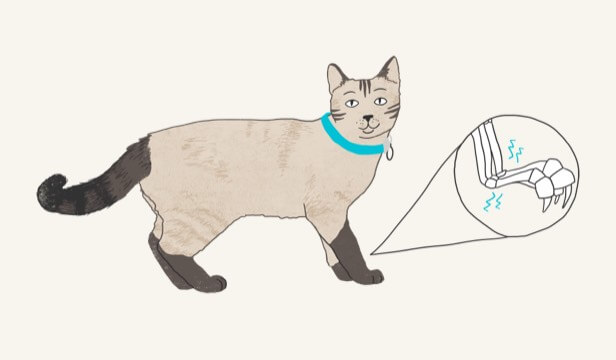Have you noticed that your cat is no longer jumping up on their favorite couch, is less interested in chasing their catnip mice, or has difficulty getting in or out of the litter box? You've unlocked a new badge of cat ownership – one earned when an observant cat owner notices these subtle, yet possibly very painful, signs. While many cat owners may attribute these signs to “slowing down” with age, they may be a sign of osteoarthritis (OA), which affects nearly 40% of all cats[3].
Osteoarthritis can be a result of poor joint structure from birth, a traumatic injury, or, most commonly in cats, normal wear and tear on their joints as they age. Surprisingly, one study showed that by the time cats reach the age of 12, more than 90% of them have bone changes visible on x-ray[1], yet few are diagnosed or treated before these irreversible changes have occurred.

Diagnosing Your Cat With Arthritis
Cats often hide painful conditions like OA from their owners and veterinarians alike. As a result, cat osteoarthritis is often underdiagnosed and undertreated until advanced stages of the disease begin – leaving them in pain and potentially damaging the bond they have with their owners.
Osteoarthritis pain can be a serious health problem for your cat. Without treatment, the pain will continue to get worse. Helping your cat begins by talking with your veterinarian and coming up with a medical treatment plan to relieve your cat’s discomfort. Your veterinarian will thoroughly examine your cat and can often make the diagnosis of arthritis on the exam alone, or with the help of x-rays (radiographs). Cats with OA may have varying signs and symptoms, and you and your veterinarian can work together to catch it in its earlier stages, to help get your cat ahead of the pain, rather than waiting to treat it.
Cat Arthritis Treatments
OA is the most common cause of chronic pain in all species[2], not just cats. Luckily, there are treatment options for cats diagnosed with OA to help with pain management and to improve their quality of life. You and your veterinarian will determine which of these arthritis treatments are appropriate based on your cat’s exact stage of the disease, their lifestyle, and overall health status.
These treatments can include:
- Monoclonal antibody targeting Nerve Growth Factor (NGF). Anti-NGF monoclonal antibodies control osteoarthritis pain with a monthly injection given by your veterinarian. Since monoclonal antibodies are proteins, your cat's body breaks down these drugs just as it does all other proteins.
- Joint support supplements and nutraceuticals.
- Special joint diets or diet modifications. Diets formulated for joint issues, particularly those with Omega-3 fatty acids, can act as a natural anti-inflammatory aid, help your cat maintain an appropriate body weight and muscle mass, and improve mobility by maintaining joint cartilage.
- Weight loss. OA is even further aggravated by obesity in cats – extra weight can cause additional strain on your cat’s joints. Weight loss may help your cat move around with less pain.
- Weight management and maintenance. If your cat’s weight is healthy, it’s essential to help keep them at a good body condition — meaning an appropriate weight and muscle mass. Your vet may recommend a particular food and/or exercise regimen to manage or maintain their weight and muscle condition.
- Exercise. Appropriate play and controlled activities can help your cat maintain their muscle mass. This includes the use of toys, feeding puzzles, or playing chase games. Making exercise a priority for your cat and playing with them regularly is great for their mental and physical health.
- NSAIDs (nonsteroidal anti-inflammatory drugs). NSAIDs are helpful for dogs with OA, however there are none that are approved to treat arthritis in cats. Human NSAIDs like Tylenol can be fatal to cats, so it’s important to work with your vet to find a medication that is safe and effective.
- Acupuncture. Acupuncture works to stimulate the nervous system by inserting very fine, specialized needles into very specific points on a cat’s body. Simulating these nerve centers can help decrease inflammation.
- Laser therapy. Laser therapy directs an exact frequency of light into the tissues to help reduce pain, increase blood flow, and decrease inflammation.
- Massage. Therapeutic massage is another method of providing cats with OA pain relief and improved tissue strength, particularly for those that may have secondary muscle tension. Some of the massage techniques can be taught to pet owners to provide their cat with some at-home muscle pain relief.
- Physical therapy/rehabilitation therapy. Physical therapy and rehabilitation can include a variety of exercises and treatments, including an underwater treadmill, swimming, passive range of motion, and stretching. Devised to meet each cat’s particular needs, these can help maintain and build muscle mass to support a weakened skeleton/joints, decrease inflammation, improve mobility, increase joint fluid production, and reduce pain.
- Pulsed electromagnetic therapy.
- PRP (platelet-rich plasma injections).
- Stem cell therapy. Stem cells are a particular type of cells that can renew themselves, reproduce, and turn into a specialized cell type where they are needed. Stem cell therapy, a kind of regenerative medicine, is when stem cells are placed into a particular area that has been damaged (like an arthritic joint). Here, the stem cells can act as a building block for the cartilage to help repair itself. The end result is an improved range of motion and enhanced joint function.
Your Cat’s Pain Can Be Relieved
Cats love the bird’s eye view, like jumping up to the windowsill for birdwatching or finding that perfect sunny spot. When those favorite spots seem out of reach for your cat, you may be seeing signs of osteoarthritis pain.
Remember that you are the best person to notice subtle signs and changes in your cat’s behavior that may signal arthritis. Be sure to mention these to your veterinarian and work together to develop a plan to keep your cat happy, healthy, and pain-free.
ZPC-00869R1
IMPORTANT SAFETY INFORMATION: For use in cats only. Women who are pregnant, trying to conceive or breastfeeding should take extreme care to avoid self-injection. Allergic reactions, including anaphylaxis, could potentially occur with self-injection. Solensia should not be used in breeding cats or in pregnant or lactating queens. Solensia should not be administered to cats with known allergy to frunevetmab. The most common adverse events reported in a clinical study were vomiting and injection site pain. See full Prescribing Information.
INDICATION: For the control of pain associated with osteoarthritis in cats.
- E.M. Hardie, et al. Radiographic evidence of degenerative joint disease in geriatric cats: 100 cases (1994-1997). J Am Vet Med Assoc, 220 (5) (2002)
- Lascelles BD, Henry JB, Brown J, et al. Cross-sectional study evaluating the prevalence of radiographic degenerative joint disease in domesticated cats. Vet Surg 2010.
- Enomoto, M, et al. Anti-Nerve Growth Factor Monoclonal Antibodies for the Control of Pain in Dogs and Cats. Vet Rec, 2019.






